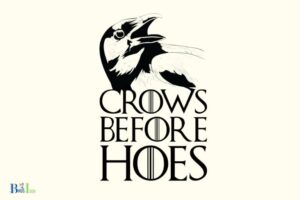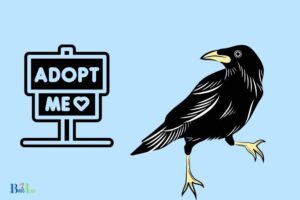What Bird Sounds Like a Crow: Blue Jay!
Many birds can mimic the sound of a crow, but the bird that is most often noted for sounding like a crow is the Blue Jay.
Blue Jays are known for their wide range of vocalizations, including the ability to imitate the calls of other birds, particularly the American Crow.
The Blue Jay, a member of the corvid family, which includes crows and ravens, has a remarkable ability to mimic the sounds of its relatives.
This mimicry serves as a form of communication and can also be used to ward off predators or rival birds.
Understanding the subtle distinctions between the Blue Jay’s imitation and the crow’s actual call involves paying attention to the tone, pitch, and repetition of the sounds.
While the Blue Jay’s mimicked ‘caw’ can be convincing, a keen ear can discern its true identity.
Observing the bird’s size, plumage, and behavior alongside the call can help birdwatchers and nature enthusiasts make the correct identification.
Blue Jays, with their striking blue and white plumage, use their amazing vocal abilities to their advantage.
By mimicking the calls of larger, more aggressive birds like crows, they effectively deter the threats lurking nearby, ensuring their own safety and survival in the wild.

Key Takeaway
Similar-sounding Bird Species
- One bird species that sounds similar to a crow is the common raven. The common raven (Corvus corax) is a large, all-black bird that is known for its deep, resonant croaking calls, which can be mistaken for those of a crow.
- However, upon closer observation, the raven’s calls are typically deeper and more guttural than those of a crow.
- Ravens are often seen in more solitary or pair-bonded situations compared to crows, which are more social and often seen in large groups.
- The common raven is highly adaptable and can be found in a variety of habitats, from forests to deserts, and even urban areas.
Its intelligence, complex vocalizations, and striking appearance make it a fascinating bird species to observe and study.
Common Vocalizations of Crows
The common vocalizations of crows are frequently characterized by a cawing sound that is distinguishable from the deep, resonant croaking calls of the common raven, which was discussed in the previous subtopic.
- Crows are highly vocal birds, using a wide range of calls to communicate with each other and other species.
- Their most familiar call is the ‘caw,’ a loud, grating cawing that is often associated with these birds.
- Crows also produce a variety of other calls, including cooing, clicking, and even a clear, melodious song.
- They use these vocalizations for a multitude of purposes, from warning of danger to indicating the location of food.
The complexity and diversity of crow vocalizations make them a fascinating subject for further study.
This intricate communication system sets the stage for understanding the distinctive calls of ravens.
Distinctive Calls of Ravens
Continuing from the previous subtopic, the distinctive calls of ravens are known for their deep, resonant croaking, contrasting with the characteristic cawing of crows.
- The raven’s vocalizations are diverse and complex, ranging from deep, guttural croaks to high-pitched squeals.
- Their calls are often described as deep, throaty, and reverberating, carrying a sense of power and mystery.
- Ravens are capable of mimicking a variety of sounds, including the calls of other bird species and even human speech, showcasing their remarkable vocal abilities.
- Furthermore, their communication is not solely vocal but also includes non-vocal components such as body language and tactile interactions.
Observing the distinctive calls of ravens provides insight into their social dynamics, territorial behavior, and complex communication systems, highlighting the fascinating nature of these intelligent birds.
Mimicking Birds in the Corvid Family
Members of the corvid family, such as crows and ravens, are known for their vocal mimicry abilities.
These birds are capable of imitating the calls of other bird species, often with remarkable accuracy.
The phenomenon of corvids mimicking the vocalizations of other birds is an intriguing area of study that sheds light on the cognitive and communicative abilities of these intelligent avian species.
Crow Vocal Mimicry
- Mimicking birds in the Corvid family, such as crows, have the remarkable ability to vocalize sounds resembling various other bird species.
- Crows are known for their exceptional vocal mimicry, often imitating the calls of other birds with remarkable accuracy.
- This behavior is particularly prominent during the breeding season, as males use mimicry to attract females and establish their territory.
- The vocal mimicry of crows extends to a wide array of bird species, including hawks, owls, and even songbirds.
- This ability to mimic a diverse range of vocalizations showcases the cognitive and communicative prowess of these highly intelligent birds.
Such vocal mimicry serves as a form of social learning within the crow community, allowing for the transmission of complex vocalizations across generations.
Corvid Imitating Other Birds
Imitating various bird species, the Corvid family, including crows, demonstrates remarkable vocal mimicry abilities.
- Members of the Corvid family such as crows, ravens, and magpies are known for their exceptional ability to mimic the sounds of other birds.
- They can accurately replicate the calls of other bird species, often to the point of confusion for human observers.
- This mimicry extends to a diverse range of avian vocalizations, from the melodious songs of songbirds to the harsh caws of raptors.
- This behavior showcases the cognitive prowess and adaptability of these intelligent birds, allowing them to integrate seamlessly into various habitats.
Understanding the Corvid family’s capacity for vocal mimicry provides valuable insights into their communication strategies and ecological interactions.
Moving forward, it’s essential to explore other birds often confused with crows.
Other Birds Often Confused With Crows
Several species are frequently mistaken for crows due to their similar vocalizations and appearance.
- The common raven, with its deep, guttural croaks, is often confused with crows.
- The fish crow shares a similar vocalization pattern and can be mistaken for crows, especially in their overlapping habitats.
- The black vulture, with its dark plumage and soaring flight, can also be misidentified as a crow from a distance.
- Furthermore, the common grackle, known for its iridescent plumage and harsh, creaking calls, may be mistaken for a crow, particularly in low-light conditions.
These birds often share habitats with crows and exhibit overlapping behaviors, further contributing to the confusion.
Understanding the subtle differences in appearance and vocalizations is crucial for accurate bird identification.
When it comes to identifying bird calls, there are several key tips to keep in mind.
Tips for Identifying Bird Calls
An important aspect of accurately identifying bird calls is to recognize the subtle differences in vocalizations and behaviors exhibited by birds that are often mistaken for crows.
- When identifying bird calls, it is essential to pay attention to the pitch, rhythm, and the specific notes or phrases in the vocalization.
- Observing the habitat and the time of day can also provide valuable clues.
- Familiarizing oneself with the common bird species in a specific area can aid in distinguishing between similar calls.
- Utilizing field guides, smartphone apps, and online resources can further support the identification process.
- It is crucial to be patient and attentive, as many bird calls may initially sound alike but possess distinct characteristics upon closer observation.
- Developing a keen ear for these nuances is key to accurately identifying bird calls and distinguishing them from crow vocalizations.
Conclusion
The identification of bird calls, particularly those that sound like crows, requires careful observation and attention to detail.
By understanding the common vocalizations of crows and their distinctive calls, as well as being aware of similar-sounding bird species and mimicking birds in the corvid family, bird enthusiasts can improve their ability to accurately identify different bird species by their calls.
It is a skill that requires practice and patience, but can be greatly rewarding in the field of birdwatching.





